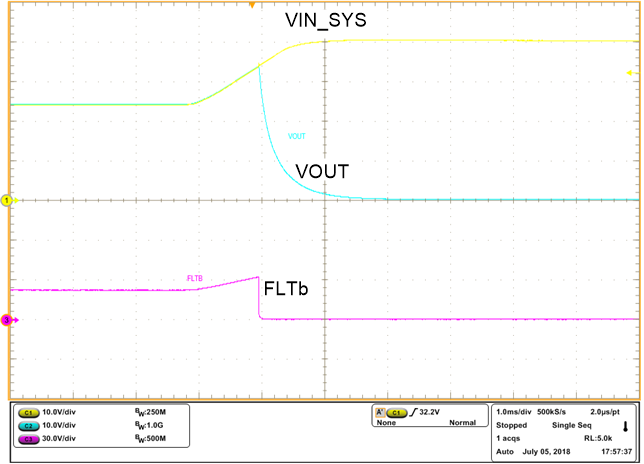ZHCSIU6F September 2018 – June 2021 TPS2663
PRODUCTION DATA
- 1 特性
- 2 应用
- 3 说明
- 4 Revision History
- 5 Device Comparison Table
- 6 Pin Configuration and Functions
- 7 Specifications
- 8 Parameter Measurement Information
-
9 Detailed Description
- 9.1 Overview
- 9.2 Functional Block Diagram
- 9.3
Feature Description
- 9.3.1 Hot Plug-In and In-Rush Current Control
- 9.3.2 PGOOD and PGTH
- 9.3.3 Undervoltage Lockout (UVLO)
- 9.3.4 Overvoltage Protection (OVP)
- 9.3.5 Input Reverse Polarity Protection (B_GATE, DRV)
- 9.3.6 Reverse Current Protection
- 9.3.7 Overload and Short Circuit Protection
- 9.3.8 Output Power Limiting, PLIM (TPS26632, TPS26633, TPS26635 and TPS26636 Only)
- 9.3.9 Current Monitoring Output (IMON)
- 9.3.10 FAULT Response ( FLT)
- 9.3.11 IN_SYS, IN, OUT and GND Pins
- 9.3.12 Thermal Shutdown
- 9.3.13 Low Current Shutdown Control (SHDN)
- 9.4 Device Functional Modes
-
10Application and Implementation
- 10.1 Application Information
- 10.2
Typical Application: Power Path Protection in a PLC System
- 10.2.1 Design Requirements
- 10.2.2 Detailed Design Procedure
- 10.2.3 Application Curves
- 10.3 System Examples
- 10.4 Do's and Don'ts
- 11Power Supply Recommendations
- 12Layout
- 13Device and Documentation Support
- 14Mechanical, Packaging, and Orderable Information
9.3.4 Overvoltage Protection (OVP)
The TPS2663x devices incorporate circuitry to protect the system during overvoltage conditions. The TPS26630 and TPS26631 feature an accurate ± 2% adjustable overvoltage cut off functionality. A voltage more than V(OVPR) on OVP pin turns off the internal FET and protects the downstream load. To program the OVP threshold externally, connect a resistor divider from IN_SYS supply to OVP terminal to GND as shown in the Simplified Schematic.
The TPS26630 and TPS26631 also feature a factory set 34.3-V input overvoltage cut off V(IN_SYS_OVP) threshold with a 440 mV hysteresis. This feature can be enabled by connecting the OVP terminal directly to the GND terminal. The TPS26632, TPS26633 and TPS26636 feature an internally fixed 35-V maximum overvoltage clamp V(OVC) functionality. The TPS26632 and TPS26633 clamps the output voltage to V(OVC), when the input voltage exceeds 35 V. TPS26635 features a fixed 39-V maximum overvoltage clamp level. During the output voltage clamp operation, the power dissipation in the internal MOSFET is PD = (V(IN_SYS) – V(OVC)) × I(OUT). Excess power dissipation for a prolonged period can increase the device temperature. To avoid this, the internal FET is operated in overvoltage clamp for a maximum duration of tOVC(dly), 162 msec (typical). After this duration, the internal FET is turned OFF and the subsequent operation of the device depends on the MODE configuration (Auto-Retry or latch OFF) setting as shown in Table 9-1.
Figure 8-1 shows the turn ON behavior when OVP pin voltage falls below V(OVPF) threshold.
Figure 9-3 illustrates the overvoltage cut-off functionality and Figure 9-4 illustrates the overvoltage clamp functionality. FLT is asserted after a delay of 617 µs (typical) after entering in overvoltage clamp mode and remains asserted until the overvoltage fault is removed.

| TPS26630 and TPS26631 | ||

| TPS26635 | RLOAD = 30 Ω, FLT connected to VOUT | |